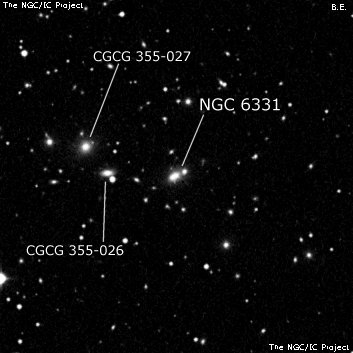
William Herschel discovered NGC 6331 = H III-951 on 20 Dec 1797 (sweep 1075) and noted "eF, S, better with 320 power." The NGC position is ~3' southwest of CGCG 355-024 = PGC 59513. Bigourdan measured an accurate position on 22 Jul 1884.
This galaxy is certainly one of the most distant in the NGC at 800 million light years (z = .059), although it is relatively easy to view, so must be intrinsically extremely bright.
400/500mm - 17.5" (5/14/88): faint, small, elongated NW-SE. A mag 13.5 star is 1.8' E. UGC 10726 lies 2.7' E. This is the brightest galaxy in AGC 2256 galaxy cluster and a triple system in a common halo.
600/800mm - 24" (8/7/13): brightest member of Abell Galaxy Cluster 2256 and first in a 6' string to the east containing a total of 6 galaxies. At 375x appeared fairly faint, fairly small, oval 5:3 NW-SE, ~30"x18", broad concentration, brighter core. This is a very close double system (two nuclei on the SDSS) with a companion on the NW side. A mag 13 star lies 1.8' E and this star is attached on the southwest side of CGCG 355-026. PGC 84834, an extremely faint and small galaxy lies 1.1' E, on line with the mag 13 star. Also in the string is UGC 10726 2.7' ENE, MCG +13-12-019 3.7' ENE, PGC 59471 4.4' SW and MCG +13-12-020 6' E. In addition, PGC 59495 lies 2.4' SW. UGC 10726: faint to fairly faint, irregularly round, ~35" diameter, broad weak concentration. This galaxy and NGC 6331 are the two largest in the cluster.
MCG +13-12-019: faint, fairly small, round, 18" diameter. PGC 59471: extremely faint and small, only 6" diameter.
MCG +13-12-020: very faint, small, round, 18" diameter, low even surface brightness. A mag 11.3 star is 1.4' E. PGC 59495: very faint, extremely small, round, 10" diameter.
Notes by Steve Gottlieb